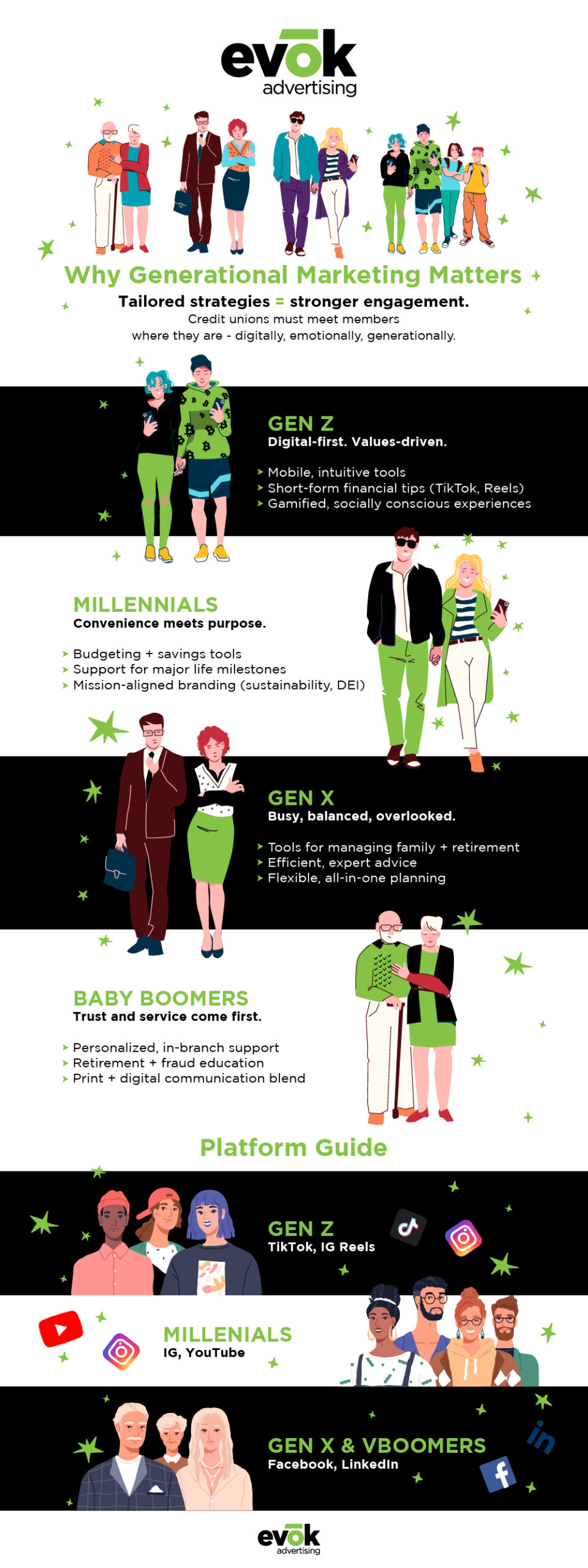
Generational Marketing for Credit Unions: Tailoring Strategies for Gen Z, Millennials, and Baby Boomers
Marketing in the financial sector has evolved far beyond one-size-fits-all messaging. Today, credit union marketing must take into account the distinct needs, values, and digital behaviors of multi-generational audiences. From Baby Boomers planning for retirement to Millennials navigating home ownership and Gen Z just starting to manage their finances, each group requires unique, data-informed approaches. For Chief Marketing Officers (CMOs) in the credit union space, developing and implementing generational marketing strategies is no longer optional – it’s essential.
As we expand on the foundational principles outlined in our Complete Credit Union Marketing Guide, this blog dives deeper into the demographics shaping the credit union landscape and the tailored strategies financial institutions must deploy to engage them effectively.

Understanding Credit Union Member Demographics
Credit union member demographics are becoming increasingly diverse. With assets ranging from lifelong members to digital-native first-time users, knowing your audience is key. The current financial services environment demands that CMOs lead with data, empathy, and innovation.
In recent years, generational shifts in membership have highlighted the need for segmentation by age group. According to CUNA, nearly 30% of new credit union members are under the age of 35, pointing to a growing base of Gen Z and Millennials. At the same time, Baby Boomers still hold significant financial influence, making them a crucial demographic.
The Economic Context Driving Generational Differences

Each generation has been shaped by distinct economic events that influence their financial behaviors and expectations. Baby Boomers experienced periods of economic growth and stability, leading to more conservative financial approaches and higher trust in traditional banking relationships. Generation X witnessed economic volatility, including the savings and loan crisis and early internet adoption, creating a blend of digital comfort and financial caution.
Millennials entered adulthood during the 2008 financial crisis, experiencing delayed homeownership, student debt burdens, and skepticism toward traditional financial institutions. This background makes them value transparency, fair pricing, and institutions that align with their values. Gen Z, meanwhile, has only known a post-recession world where digital-first solutions and economic uncertainty are the norm, driving their preference for flexible, mobile-native financial tools.
Understanding these formative experiences helps credit unions craft messaging that resonates with each group’s underlying motivations and concerns. It’s not just about age – it’s about how the economic and technological landscape has shaped their financial worldview.
Gen Z: Reaching the Financial Newcomers with Digital Savvy

Gen Z is redefining the banking experience. Born into a digital world, these consumers expect seamless, mobile-first interactions. For credit unions, marketing to this group means going beyond traditional methods and embracing platforms and content that speak their language.
To connect with Gen Z, prioritize mobile-first experiences and social responsibility. Ensure your digital tools and mobile banking platforms are not only intuitive but also align with their values. Gen Z gravitates toward brands that support social causes and demonstrate authenticity. Credit unions should emphasize their nonprofit status and highlight community-driven initiatives.
Content creation is key. Develop short-form video content that offers practical financial tips and showcases your organization’s personality. Platforms like TikTok, Instagram Reels, and YouTube Shorts are ideal for engaging this audience. Educational content around budgeting, credit building, and investing should be digestible and visually appealing.
Advanced Gen Z Engagement Strategies

Gen Z’s financial behaviors are distinctly different from previous generations at the same age. They’re more likely to use digital payment platforms, invest in individual stocks, and seek financial advice from social media influencers rather than traditional advisors. Credit unions must adapt by creating content that meets them where they are.
Consider developing a micro-learning financial education series that can be consumed in under 60 seconds. Topics like “How to Build Credit in College,” “Side Hustle Banking Tips,” or “Crypto vs. Traditional Savings” are popular with this demographic. Partner with financial influencers who align with your credit union’s values to expand reach authentically.
Gamification elements can significantly boost engagement with Gen Z members. Consider implementing savings challenges, financial milestone badges, or referral rewards that feel more like social media interactions than traditional banking. These features should be seamlessly integrated into your mobile app experience.
For more on building impactful Gen Z strategies, check out our blog on leveraging digital media for younger audiences and explore insights from PYMNTS and CULytics.
Millennials: Bridging Convenience with Purpose
Millennials, now in their prime earning years, are looking for financial institutions that align with their lifestyle and values. They seek convenience through technology but also want to feel a personal connection to their financial services provider.
Personalized tools like budgeting apps, savings trackers, and custom loan calculators resonate well. These tools should be available across mobile and desktop platforms and backed by educational resources that empower users. Email campaigns, webinars, and blogs are excellent avenues to share financial tips and product updates.
This generation also values purpose-driven branding. They’re more likely to support institutions that support causes they care about, such as sustainability, local business development, or DEI initiatives. Highlight these values through authentic storytelling across your digital and in-branch channels.
Millennial-Specific Financial Challenges and Solutions

Millennials face unique financial pressures that credit unions are well-positioned to address. With student loan debt averaging over $30,000 per borrower and housing costs consuming larger portions of income than previous generations experienced, this demographic needs sophisticated financial solutions and empathetic support.
Create targeted campaigns around major life events that Millennials are navigating: first-time home buying, wedding financing, starting families, and career transitions. Develop an educational content series that addresses these milestones with practical advice and highlights how your credit union’s products can help achieve these goals.
Consider offering innovative products that speak to Millennial values and lifestyles. This might include sustainable investment options, flexible loan terms for gig economy workers, or family planning savings accounts with educational resources. The key is combining product innovation with clear communication about how these offerings align with their life goals and values.
Millennials also respond well to peer testimonials and case studies. Feature real member stories about achieving financial goals with your credit union’s help. This social proof, combined with data-driven insights about product benefits, creates compelling marketing content that builds trust and drives conversions.
Baby Boomers: Honoring Legacy with High-Touch, High-Trust Engagement

Though often overlooked in digital strategies, Baby Boomers represent a financially powerful segment. Many are managing retirement planning, estate transfers, or long-term care services, and credit unions are well-positioned to provide these services.
Personalized member support is critical for this demographic. Boomers appreciate being able to speak with a knowledgeable advisor in-branch or over the phone. These interactions help build trust and convey the institution’s commitment to service.
Education remains a top priority. Provide print and digital guides on topics such as IRA rollovers, fraud prevention, and long-term savings. While Boomers are increasingly tech-savvy, a balanced approach that combines digital and traditional communication methods will prove most effective.
Expanding Boomer-Focused Services and Communications
Baby Boomers control significant wealth and are entering a phase where they need specialized financial services. Many are transitioning from wealth accumulation to wealth preservation and distribution, creating opportunities for credit unions to provide high-value advisory services.
Develop comprehensive retirement planning workshops that combine in-person and digital elements. Topics should include Social Security optimization, healthcare cost planning, estate planning basics, and fraud protection. These educational initiatives position your credit union as a trusted advisor during critical financial decisions.
Consider creating dedicated communication channels for Boomers, such as printed newsletters highlighting digital tools alongside traditional services. This hybrid approach acknowledges their growing digital comfort while respecting their preference for tangible communication. Include QR codes in print materials to bridge the gap between physical and digital experiences.
Boomers also represent an untapped opportunity for reverse mentoring programs, where they can share financial wisdom with younger members in exchange for digital literacy support. These intergenerational programs strengthen community ties while providing value to multiple member segments.
Generation X: The Often-Overlooked Bridge Generation
While much attention focuses on the extremes of the generational spectrum, Generation X represents a crucial bridge demographic that combines elements of both digital adoption and traditional service expectations. This generation, now in their peak earning years with significant family and financial responsibilities, requires targeted strategies that acknowledge their unique position.
Gen X members are simultaneously managing mortgage payments, children’s education expenses, aging parent care, and their retirement planning. They appreciate efficiency and expertise, valuing institutions that can provide comprehensive solutions without requiring extensive time investment. Create streamlined communication that respects their busy schedules while providing the detailed information needed for major decisions.
This demographic responds well to comprehensive financial planning tools that integrate multiple life goals. Consider developing family financial dashboard features that allow them to track college savings, retirement contributions, and debt payoff progress in one consolidated view. Educational content should focus on optimizing financial strategies across multiple competing priorities.
Multi-Generational Banking Strategies: Bridging the Gap
CMOs must navigate the complexities of multi-generational marketing with agility. That means knowing when to segment and when to unify messaging. Tailoring customer journeys to each age group increases engagement and satisfaction. A Gen Z user might favor a self-service chatbot and gamified app, while a Boomer prefers a personalized conversation and printed newsletter.
At the same time, some themes resonate across generations. Campaigns focused on fraud prevention, savings goals, and financial literacy have universal appeal. Credit unions can create core messaging and adapt visuals, platforms, and tone to match each audience.
Flexibility in product design is also essential. Modular financial tools, such as customizable checking accounts or tiered credit cards, can meet the needs of younger adults building credit and older members managing wealth.
Advanced Segmentation and Personalization Techniques

Modern marketing technology enables sophisticated segmentation that goes beyond simple age brackets. Consider behavioral segmentation that combines generational preferences with individual member actions, preferences, and life stage indicators. This approach allows for more nuanced messaging that resonates with specific subgroups within each generation.
Implement dynamic content systems that automatically adjust website experiences, email campaigns, and app interfaces based on member profiles. A 25-year-old member might see content about building credit and student loan management, while a 45-year-old sees mortgage refinancing options and college planning tools, and a 65-year-old sees retirement distribution strategies and estate planning resources.
Cross-generational marketing campaigns can be particularly effective for credit unions. Consider initiatives that bring different generations together, such as financial literacy programs where Boomers share wisdom while learning about digital tools from younger members. These community-building activities reinforce the credit union’s cooperative values while serving multiple demographics simultaneously.
Great case studies and insights are also available through Coviance and CUInsight.
Partnering with a marketing agency like Evok means tapping into expertise across all generations of consumers. Our tailored strategies are designed to keep your messaging relevant, authentic, and results-driven.
Leveraging Social Media for Credit Union Growth
Social media is no longer just a marketing tool; it’s a service channel, trust-builder, and brand amplifier. Whether it’s an Instagram campaign on student loan tips or a Facebook series on retirement readiness, social platforms offer powerful tools for engagement.
To succeed, identify where each generation spends their time online:
- Gen Z: TikTok and Instagram; prioritize short-form video content.
- Millennials: Instagram and YouTube; mix education with lifestyle content.
- Boomers: Facebook and LinkedIn; focus on longer-form posts, community involvement, and security tips.
Use data analytics to track engagement by age group and refine your approach. Consider using paid ads, stories, and interactive content like polls or quizzes to drive interest and clicks.
Advanced Social Media Strategies by Platform

Each social media platform offers unique opportunities for generational targeting that go beyond basic demographic considerations. Understanding platform-specific features and user behaviors enables more sophisticated engagement strategies.
On TikTok, create financial education content that feels native to the platform. This might include “day in the life” content from credit union employees, financial myth-busting videos, or collaborative content with other local businesses. The key is authenticity and entertainment value combined with educational content.
Instagram offers opportunities for both short-form video content and more polished, lifestyle-oriented posts. Use Instagram Stories for time-sensitive content like rate announcements or event promotions, while maintaining a consistent feed aesthetic that reflects your brand values. Instagram’s shopping features can also showcase financial products in an approachable way.
LinkedIn serves dual purposes for credit union marketing: reaching professional Millennials and Gen X members while positioning leadership as thought leaders in the financial services space. Share industry insights, member success stories, and participate in professional conversations about financial trends.
Facebook remains crucial for reaching Boomers and Gen X, but success requires understanding that these users engage differently than younger demographics. They prefer longer-form content, are more likely to share articles, and value community discussion features. Use Facebook Groups to create member communities around specific interests or life stages.
Building Financial Literacy Across All Generations
Financial literacy is a universal need and a differentiator for credit union marketing. Positioning your institution as a trusted source of education builds long-term loyalty.
Campaigns should be tailored by age group but unified under a central theme: helping members make informed financial decisions. A digital hub that offers tools like calculators, articles, and video content can provide ongoing value. Hosting webinars or Q&A sessions, segmented by life stage, further personalizes the experience.
You can also expand your reach through partnerships with schools, universities, and local nonprofits, establishing your credit union as a community leader in financial education.
Innovative Educational Content Strategies

Financial education content must evolve beyond traditional formats to engage modern audiences effectively. Consider developing interactive content that adapts to different learning styles and generational preferences.
Create choose-your-own-adventure-style financial planning tools that help members explore different scenarios and outcomes. These interactive experiences can address complex topics like retirement planning or home buying in an engaging, non-intimidating way that appeals to visual and kinesthetic learners across all generations.
Develop a podcast series that dives deep into financial topics while maintaining accessibility. Podcasts work well for busy Millennials and Gen X members who can consume content during commutes, while also appealing to Boomers who appreciate longer-form educational content.
Consider virtual reality or augmented reality experiences for complex financial concepts. While primarily appealing to younger demographics, these immersive tools can help all generations better understand abstract concepts like compound interest or investment risk through visual and interactive demonstrations.
Elevating Your Credit Union Marketing Strategy

Marketing by age group allows credit unions to deepen relationships and deliver value at every stage of life. By understanding credit union member demographics and tailoring your approach, you can create more impactful, long-lasting member experiences.
Evok’s extensive experience with financial institutions enables us to craft results-driven, multi-channel campaigns that resonate with every generation. From digital banking preferences to values-based messaging, we help you deliver member-centric solutions that stand out in today’s competitive landscape.
Ready to take your credit union marketing strategy to the next level? Contact us to learn how we can help.